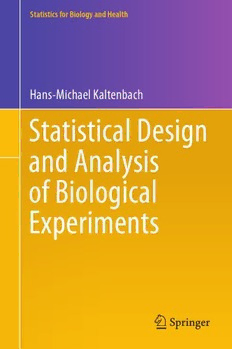Table Of ContentStatistics for Biology and Health
Hans-Michael Kaltenbach
Statistical Design
and Analysis
of Biological
Experiments
Statistics for Biology and Health
SeriesEditors
MitchellGail,DivisionofCancerEpidemiologyandGenetics,NationalCancer
Institute,Rockville,MD,USA
JonathanM.Samet,DepartmentofEpidemiology,SchoolofPublicHealth,Johns
HopkinsUniversity,Baltimore,MD,USA
Statistics for Biology and Health (SBH) includes monographs and advanced text-
books on statistical topics relating to biostatistics, epidemiology, biology, and
ecology.
Moreinformationaboutthisseriesathttp://www.springer.com/series/2848
Hans-Michael Kaltenbach
Statistical Design
and Analysis of Biological
Experiments
Hans-MichaelKaltenbach
DepartmentofBiosystemsScience
andEngineering,ETHZürich
Basel,Switzerland
ISSN1431-8776 ISSN2197-5671 (electronic)
StatisticsforBiologyandHealth
ISBN978-3-030-69640-5 ISBN978-3-030-69641-2 (eBook)
https://doi.org/10.1007/978-3-030-69641-2
©SpringerNatureSwitzerlandAG2021
Thisworkissubjecttocopyright.AllrightsarereservedbythePublisher,whetherthewholeorpartof
thematerialisconcerned,specificallytherightsoftranslation,reprinting,reuseofillustrations,recitation,
broadcasting,reproductiononmicrofilmsorinanyotherphysicalway,andtransmissionorinformation
storageandretrieval,electronicadaptation,computersoftware,orbysimilarordissimilarmethodology
nowknownorhereafterdeveloped.
Theuseofgeneraldescriptivenames,registerednames,trademarks,servicemarks,etc.inthispublication
doesnotimply,evenintheabsenceofaspecificstatement,thatsuchnamesareexemptfromtherelevant
protectivelawsandregulationsandthereforefreeforgeneraluse.
Thepublisher,theauthorsandtheeditorsaresafetoassumethattheadviceandinformationinthisbook
arebelievedtobetrueandaccurateatthedateofpublication.Neitherthepublishernortheauthorsor
theeditorsgiveawarranty,expressedorimplied,withrespecttothematerialcontainedhereinorforany
errorsoromissionsthatmayhavebeenmade.Thepublisherremainsneutralwithregardtojurisdictional
claimsinpublishedmapsandinstitutionalaffiliations.
ThisSpringerimprintispublishedbytheregisteredcompanySpringerNatureSwitzerlandAG
Theregisteredcompanyaddressis:Gewerbestrasse11,6330Cham,Switzerland
ForElke
Preface
This book serves as an introduction to the design and analysis of experiments and
usesexamplesfrombiologyandlifesciences.Itisaimedatstudentsandresearchers
wantingtogainorrefreshknowledgeofexperimentaldesign.Previousexposureto
astandardstatisticsintroductionwouldbehelpful,buttherequiredmaterialisalso
reviewedinthefirstchapterstomakethebookself-contained.Mostcalculationsare
demonstratedinR,butshouldbeeasilytransferabletoothersoftware.
ThemainfeatureofthisbookistheuseofHassediagramstoconstructandvisu-
alizeadesign.Thesediagramsclarifyandsimplifymanyideasinexperimentaldesign
yethavereceivedlittleattentionforteaching.Theyallowmetofocusonthelogical
structureofanexperimentaldesign,facilitatecomparisonsbetweendesigns,cleanly
separatetreatmentsfromunits,andmaketherandomizationmoreexplicit.Thevisu-
alizationbyHassediagramsencouragestryingdifferentmodificationsofadesign,
and an appropriate linear model and its specification in R are then easily derived
fromagivendiagram.Theanalysisofvariancetechniquesarecarefullydeveloped
from basic principles, and I exploit Hasse diagrams to derive model specifications
forlinearmixedmodelsasamodernalternativeformorecomplexdesigns.
I aimed at keeping the book concise enough to be read cover-to-cover, yet to
includethestandardexperimentaldesignsfoundinbiologicalresearch.Ialsodiscuss
fractionalfactorialandresponsesurfacedesignsthatprovedinvaluableforoptimizing
experimental conditions in my own practice. I believe that power analysis is an
importantpartofexperimentaldesignanddiscussthistopicindetail;thisincludes
‘portablepower’asaquick-and-dirtytoolforapproximatesamplesizecalculations
thatIhavenotseenanywhereelse.Finally,Istronglyemphasizeestimationandeffect
sizesovertestingand p-valuesandthereforediscusslinearcontrastsatconsiderable
length;Ialsopresentstandardizedeffectsizesusuallynotdiscussedintextsinthe
biomedicalsciences.
Inadvancingthroughthematerial,Irelyonasinglemainexample—drugsand
diets and their effect on mice—and use artificial data for illustrating the analyses.
Thisapproachhastheadvantage thatthescientificquestionsandtheexperimental
detailscanbehandledrathereasily,whichallowsmetointroducenewdesignsand
analysistechniquesinanalreadyfamiliarsetting.Italsoemphasizeshowthesame
treatments and experimental material can be organized and combined in different
vii
viii Preface
ways,whichresultsindifferentdesignswithverydifferentproperties.Realexper-
iments always have their own idiosyncrasies, of course, and rarely oblige the nice
andcleandesignfoundinatextbook.Toallowforthisfact,Idiscussseveralreal-life
exampleswithalltheirdeviationsfromthemostelegantdesigns,failedobservations,
andalternativeinterpretationsoftheresults;thesemostlyoriginatefromconsultation
andcollaborationwithcolleaguesatmydepartment.
The book is organized in three main parts: Chaps. 1–3 introduce the design of
experimentsandtheassociatedvocabulary,andprovideabriefbutthoroughreview
ofstatisticalconcepts.Readersfamiliarwiththematerialofastandardintroductory
statisticsclassmightreadChap.1andthenskimthroughChaps.2–3toabsorbthe
notation and get acquainted with Hasse diagrams and the introductory examples.
ThemaindesignsandanalysistechniquesarediscussedinChaps.4–8.Thismate-
rial provides the core of an introductory design of experiments class and includes
completelyrandomizedandblockeddesigns,factorialtreatmentdesigns,andsplit-
unitdesigns.Chapters9–10introducetwomoreadvancedmethodsanddiscussthe
mainideasoffractionalfactorialdesignsforhandlinglargerexperimentsandfactor
screening,andofresponsesurfacemethodsforoptimization.
Iamindebtedtomanypeoplewhocontributedtothisbook.LekshmiDharmarajan
andJuliaDeichmanntaughttutorialsandoftensufferedthroughlast-minutechanges
whilethematerialandexpositiontookshape.Theyalsoprovidedvaluablecomments
on earlier versions of the text. Many students at the Department of Biosystems
ScienceandEngineeringatETHZurichprovidedcorrectionsandhelpfulfeedback.
ChristianLohaszandAndreasHierlemannwerekindenoughtoallowmetousetheir
tumordiameterdata,andTaniaRobertsandFabianRudolfdidthesamefortheyeast
mediumexample.CristinaLoureiroCasalderreyworkedontheyeasttransformation
example.Mywifeenduredcountlesshoursofmelockedawayinanoffice,staring
andmumblingatacomputerscreen.JörgStellinggenerouslygrantedmetimeand
supportforwritingthisbook.Thankyouall!
Finally, https://gitlab.com/csb.ethz/doe-book provides datasets and R-code for
mostexamplesaswellaserrata.
Basel,Switzerland Hans-MichaelKaltenbach
November2020
Contents
1 PrinciplesofExperimentalDesign .............................. 1
1.1 Introduction ............................................. 1
1.2 ACautionaryTale ........................................ 2
1.3 TheLanguageofExperimentalDesign ...................... 3
1.4 ExperimentValidity ...................................... 4
1.4.1 ConstructValidity ................................ 5
1.4.2 InternalValidity .................................. 5
1.4.3 ExternalValidity .................................. 7
1.5 ReducingtheRiskofBias ................................. 8
1.5.1 RandomizationofTreatmentAllocation .............. 8
1.5.2 Blinding ......................................... 9
1.5.3 AnalysisPlanandRegistration ...................... 10
1.6 NotesandSummary ...................................... 11
References .................................................... 12
2 ReviewofStatisticalConcepts .................................. 15
2.1 Introduction ............................................. 15
2.2 Probability .............................................. 15
2.2.1 RandomVariablesandDistributions ................. 15
2.2.2 Quantiles ........................................ 16
2.2.3 IndependenceandConditionalDistributions .......... 17
2.2.4 ExpectationandVariance .......................... 18
2.2.5 CovarianceandCorrelation ........................ 21
2.2.6 SomeImportantDistributions ...................... 23
2.3 Estimation .............................................. 27
2.3.1 PropertiesofEstimators ........................... 28
2.3.2 EstimatorsofExpectationandVariance .............. 29
2.3.3 StandardErrorandPrecision ....................... 31
2.3.4 ConfidenceIntervals .............................. 32
2.3.5 EstimationforComparingTwoSamples ............. 35
2.4 TestingHypotheses ....................................... 41
2.4.1 TheLogicofFalsification .......................... 41
ix
x Contents
2.4.2 Thet-Test ....................................... 43
2.4.3 p-ValuesandStatisticalSignificance ................ 43
2.4.4 FourAdditionalTestStatistics ...................... 47
2.5 NotesandSummary ...................................... 49
References .................................................... 51
3 PlanningforPrecisionandPower ............................... 53
3.1 Introduction ............................................. 53
3.2 BalancingAllocation ..................................... 53
3.3 ReducingtheStandardError ............................... 55
3.3.1 Sub-sampling .................................... 55
3.3.2 NarrowingtheExperimentalConditions .............. 56
3.3.3 Blocking ........................................ 56
3.4 SampleSizeandPrecision ................................. 57
3.4.1 SampleSizeforDesiredPrecision ................... 58
3.4.2 PrecisionforGivenSampleSize .................... 59
3.5 SampleSizeandPower ................................... 59
3.5.1 PowerAnalysisforKnownVariance ................. 60
3.5.2 PowerAnalysisforUnknownVariance .............. 62
3.5.3 PowerAnalysisinPractice ......................... 65
3.5.4 ‘ObservedPower’andRelatedFallacies .............. 65
3.6 NotesandSummary ...................................... 67
References .................................................... 68
4 ComparingMoreThanTwoGroups:One-WayANOVA .......... 69
4.1 Introduction ............................................. 69
4.2 ExperimentandData ..................................... 69
4.3 One-WayAnalysisofVariance ............................. 70
4.3.1 Testing Equality of Means by Comparing
Variances ........................................ 71
4.3.2 AnalysisofVariance .............................. 72
4.3.3 EffectSizeMeasures .............................. 75
4.4 PowerAnalysisandSampleSizeforOmnibus F-test .......... 76
4.4.1 GeneralIdea ..................................... 77
4.4.2 DefiningtheMinimalEffectSize ................... 78
4.4.3 CalculatingPower ................................ 79
4.4.4 PowerAnalysisinPractice ......................... 81
4.4.5 PortablePower ................................... 81
4.5 HasseDiagramsandLinearModelSpecification .............. 82
4.5.1 HasseDiagramsofExperimentStructure ............. 83
4.5.2 TheLinearModel ................................. 87
4.5.3 AnalysisofVarianceinR .......................... 88
4.6 UnbalancedData ......................................... 90
4.6.1 AnalysisofVariance .............................. 90
4.6.2 EstimatingtheGrandMean ........................ 91
4.6.3 DegreesofFreedom ............................... 92

